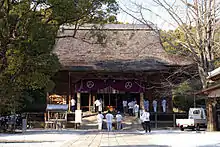| Chikurin-ji 竹林寺 | |
|---|---|
 | |
| Religion | |
| Affiliation | Shingon |
| Deity | Monju Bosatsu |
| Location | |
| Location | Kōchi, Kōchi-ken |
| Country | Japan |
| Architecture | |
| Founder | Gyōki |
| Completed | early 8th century |

Chikurin-ji (竹林寺) is a Shingon temple in Kōchi, Kōchi Prefecture, Japan. Temple 31 on the Shikoku 88 temple pilgrimage, the main image is of Monju Bosatsu. The temple is said to have been founded by Gyōki in the early eighth century.[1][2]
The temple houses a number of important sculptures and its late Edo-period gardens are a Natural Monument.[3]
Buildings
- Hondō, late Muromachi period, 5x5 bay, single storey, with a hip-and-gable shingle roof (Important Cultural Property)[4][5][6]
- Reception hall, Edo period (Prefectural Cultural Property)[7]
- Sanmon
- Five-storey pagoda
- Shōrō
- Daishidō
Treasures
- Wooden pentad of Monju Bosatsu (late Heian period) (ICP)[8]
- Standing wooden statue of Amida Nyorai (late Heian period) (ICP)[9]
- Standing wooden statues of Tamonten and Zōjōten (late Heian period) (ICP)[10]
- Seated wooden statue of Yakushi (late Heian period) (ICP)[11]
- Standing wooden statue of Jūichimen Kannon (late Heian period) (ICP)[12]
- Seated wooden statue of Shaka Nyorai (late Heian period) (ICP)[13]
- Standing wooden statue of Seishi Bosatsu (late Heian period) (ICP)[14]
- Wooden statue of Daiitoku Myōō seated on a cow (Kamakura period) (ICP)[15]
- Seated wooden statue of Aizen Myōō (Kamakura period) (ICP)[16]
- Standing wooden statue of Senjū Kannon (Kamakura period) (ICP)[17]
- Seated wooden statue of Amida Nyorai (Kamakura period) (ICP)[18]
- Standing wooden statue of Byakue Kannon (Muromachi period) (ICP)[19]
- Standing wooden statue of Batō Kannon (Muromachi period) (ICP)[20]
- Seated wooden statue of Dainichi Nyorai (Muromachi period) (ICP)[21]
- Kakebotoke with seated Monju Bosatsu (1654) (Prefectural Cultural Property)[22]
- Temple bell (1284) (Prefectural Cultural Property)[23]
See also
Wikimedia Commons has media related to Chikurinji (Kochi).
References
- ↑ Miyata, Taisen (2006). The 88 Temples of Shikoku Island, Japan. Koyasan Buddhist Temple, Los Angeles. p. 77.
- ↑ Miyazaki, Tateki (2004). Shikoku henro hitori aruki dōgyō-ninin. Matsuyama. p. 55.
- ↑ "Chikurinji - Gardens". Kōchi City. Retrieved 30 January 2012.
- ↑ "Chikurinji - Hondō". Agency for Cultural Affairs. Retrieved 30 January 2012.
- ↑ "Chikurinji - Hondō". Kōchi Prefecture. Archived from the original on 5 August 2012. Retrieved 30 January 2012.
- ↑ "Chikurinji - Hondō". Kōchi City. Retrieved 30 January 2012.
- ↑ "Chikurinji - Kyakuden". Kōchi City. Retrieved 30 January 2012.
- ↑ "Chikurinji - Monju Bosatsu". Kōchi City. Retrieved 30 January 2012.
- ↑ "Chikurinji - Amida". Kōchi City. Retrieved 30 January 2012.
- ↑ "Chikurinji - Tamonten & Zōchōten". Kōchi City. Retrieved 30 January 2012.
- ↑ "Chikurinji - Yakushi". Kōchi City. Retrieved 30 January 2012.
- ↑ "Chikurinji - Jūichimen Kannon". Kōchi City. Retrieved 30 January 2012.
- ↑ "Chikurinji - Shaka Nyorai". Kōchi City. Retrieved 30 January 2012.
- ↑ "Chikurinji - Seishi Bosatsu". Kōchi City. Retrieved 30 January 2012.
- ↑ "Chikurinji - Daiitoku Myōō". Kōchi City. Retrieved 30 January 2012.
- ↑ "Chikurinji - Aizen Myōō". Kōchi City. Retrieved 30 January 2012.
- ↑ "Chikurinji - Senjū Kannon". Kōchi City. Retrieved 30 January 2012.
- ↑ "Chikurinji - Amida Nyorai". Kōchi City. Retrieved 30 January 2012.
- ↑ "Chikurinji - Byakue Kannon". Kōchi City. Retrieved 30 January 2012.
- ↑ "Chikurinji - Batō Kannon". Kōchi City. Retrieved 30 January 2012.
- ↑ "Chikurinji - Dainichi Nyorai". Kōchi City. Retrieved 30 January 2012.
- ↑ "Chikurinji - Kakebotoke". Kōchi City. Retrieved 30 January 2012.
- ↑ "Chikurinji - Bell". Kōchi City. Retrieved 30 January 2012.
External links
- (in Japanese) Chikurinji homepage
This article is issued from Wikipedia. The text is licensed under Creative Commons - Attribution - Sharealike. Additional terms may apply for the media files.